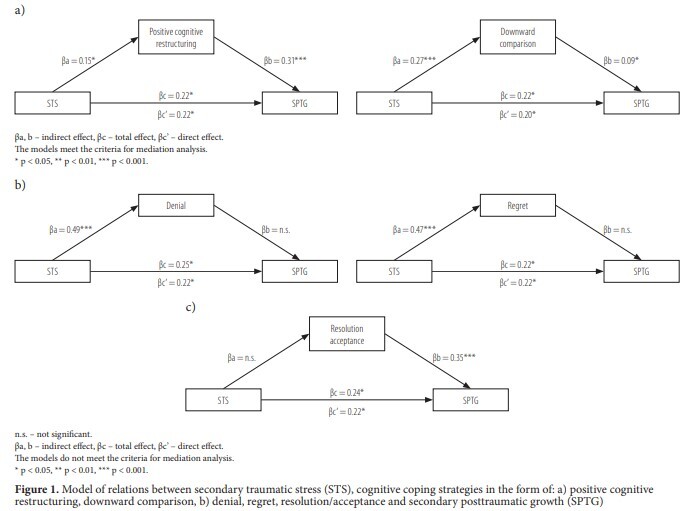Online first
Bieżący numer
Archiwum
Najczęściej cytowane 2024
O czasopiśmie
Zespół Redakcyjny
Komitet Redakcyjny
Polityka prawno-archiwizacyjna
Kup czasopismo
Klauzula informacyjna o przetwarzaniu danych osobowych
Deklaracja dostępności
Instrukcje dla Autorów
Instrukcje dla Recenzentów
Polecamy
Kontakt
Recenzenci
2024
2023
2022
2021
2020
2019
2018
2017
2016
2015
2014
2013
Redakcja i tłumaczenia
PRACA ORYGINALNA
From negative to positive effects of secondary exposure to trauma – the mediating role of cognitive coping strategies
1
University of Lodz, Łódź, Poland (Department of Health Psychology, Institute of Psychology)
2
WSB Merito University, Łódź, Poland
Data publikacji online: 11-12-2023
Autor do korespondencji
Paulina Michalska
University of Lodz, Department of Health Psychology, Institute of Psychology, Al. Rodziny Scheiblerów 2, 90-128 Łódź, Poland
University of Lodz, Department of Health Psychology, Institute of Psychology, Al. Rodziny Scheiblerów 2, 90-128 Łódź, Poland
Med Pr Work Health Saf. 2023;74(6):449-60
SŁOWA KLUCZOWE
stressprofessionalsexposure to secondary traumasecondary posttraumatic stresssecondary posttraumatic growthcognitive coping strategies
DZIEDZINY
STRESZCZENIE
Background: Professionals working with trauma victims can experience both negative and positive effects following exposure to secondary trauma. The aim of the study was to determine the relationship between secondary traumatic stress (STS), secondary posttraumatic growth (SPTG) and cognitive coping strategies and to establish the mediating role of cognitive coping strategies in the relationship between STS and SPTG. Material and Methods: A group of 500 professionals working with trauma survivors were surveyed. The Secondary Traumatic Stress Inventory, the Secondary Posttraumatic Growth Inventory and the Cognitive Processing of Trauma Scale was used. Results: The results indicated that 29% of professionals demonstrate a high intensity of STS, and nearly 34% exhibit a high level of SPTG. Denial and regret were positively correlated with STS; positive cognitive restructuring, resolution/acceptance and downward comparison were positively related to SPTG. Two cognitive coping strategies, i.e., positive cognitive restructuring and downward comparison, were found to act as mediators in the relationship between STS and SPTG. Conclusions: Understanding the effects of secondary exposure to trauma and the coping responses of professionals working with trauma survivors will support the development of prevention and intervention actions aimed at protecting them from the deleterious impact of exposure to secondary trauma at work and promoting secondary posttraumatic growth. Med Pr Work Health Saf. 2023;74(6):449–60.
Udostępnij
ARTYKUŁ POWIĄZANY
Przetwarzamy dane osobowe zbierane podczas odwiedzania serwisu. Realizacja funkcji pozyskiwania informacji o użytkownikach i ich zachowaniu odbywa się poprzez dobrowolnie wprowadzone w formularzach informacje oraz zapisywanie w urządzeniach końcowych plików cookies (tzw. ciasteczka). Dane, w tym pliki cookies, wykorzystywane są w celu realizacji usług, zapewnienia wygodnego korzystania ze strony oraz w celu monitorowania ruchu zgodnie z Polityką prywatności. Dane są także zbierane i przetwarzane przez narzędzie Google Analytics (więcej).
Możesz zmienić ustawienia cookies w swojej przeglądarce. Ograniczenie stosowania plików cookies w konfiguracji przeglądarki może wpłynąć na niektóre funkcjonalności dostępne na stronie.
Możesz zmienić ustawienia cookies w swojej przeglądarce. Ograniczenie stosowania plików cookies w konfiguracji przeglądarki może wpłynąć na niektóre funkcjonalności dostępne na stronie.






